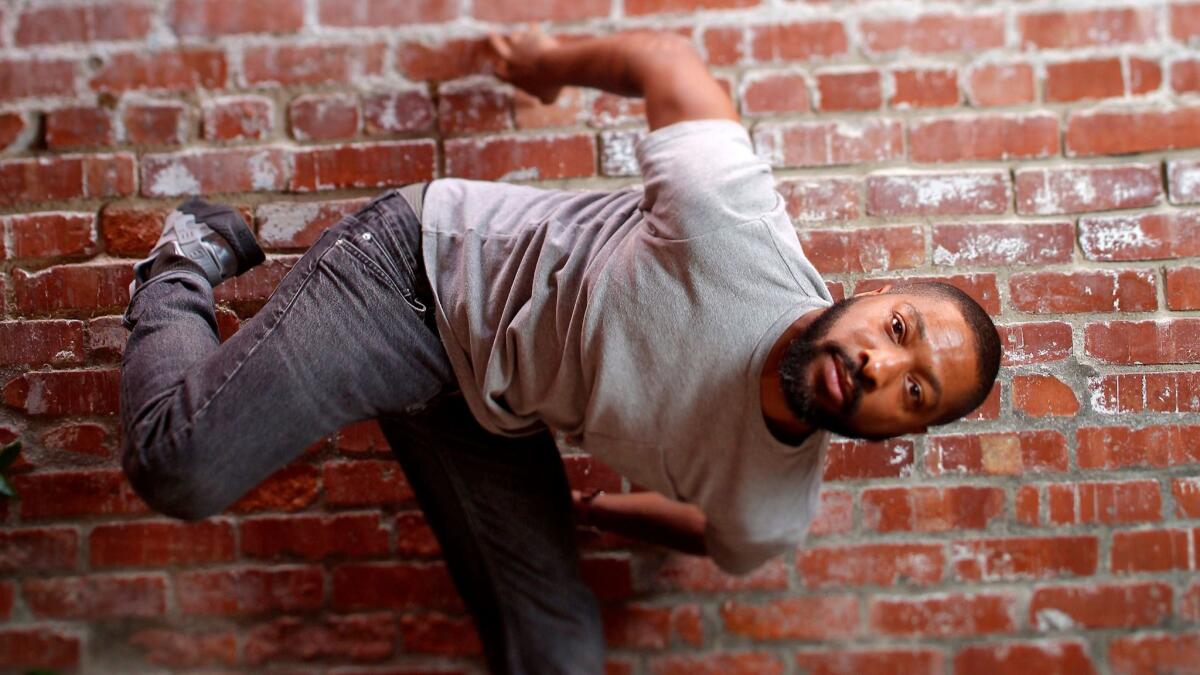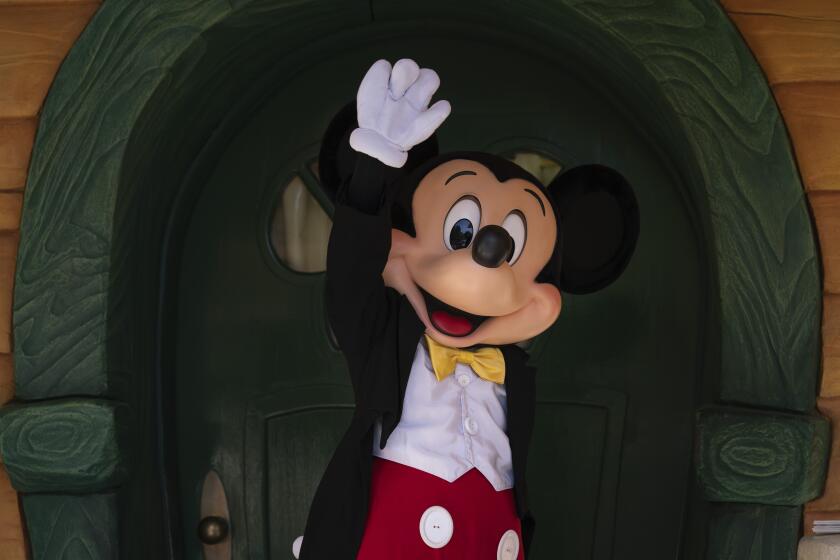Choreographer Kyle Abraham on race, the MacArthur curse and dancing to Kendrick and Kanye

- Share via
In the Brockus Project Studio downtown, acclaimed contemporary choreographer Kyle Abraham is giving a master class as part of the ongoing Los Angeles Dance Festival. Wearing loose black pants and an olive T-shirt that reveals his powerful, compact physique as well as a gallery of arm tattoos, he guides 12 women through increasingly complex movement combinations — including an excerpt from one of his past works. A sense of easy, convivial mastery pervades the room.
At 39, Abraham is establishing local roots — a home in Eagle Rock, teaching responsibilities at UCLA, classes and performances in community venues. On Friday and Saturday his company, Abraham.In.Motion, dances at the Broad Stage in Santa Monica. But his Southland calling card this year was “Untitled America,” a dark, uncompromising study of personal and societal imprisonment that prompted explosive ovations when performed by the Alvin Ailey American Dance Theater at the Music Center in March.
Abraham is no stranger to ovations, having won nearly all of the most prestigious dance awards, as well as a coveted MacArthur Fellowship, the so-called genius grant that comes with a stipend of $625,000. But in an interview, Abraham’s sunny charm yields to repeated expressions of self-doubt — what he calls unplanned shifts in his personal life and career that included a two-year period in which he stopped dancing because of what he terms a near-suicidal response to making onstage mistakes. The conversation has been edited for length and clarity.
How would you describe your movement style to someone who has never seen your work?
What I usually say in an elevator pitch is that it’s a postmodern gumbo. I like to explain what we do as a hybrid of movement sensibilities inspired by a lot of postmodern, modern, contemporary and ballet forms and even some social-dance vernaculars as well.
Having that and a start in rave culture, and being raised at a time when hip-hop was being birthed, I think all of that finds its way into the way I improvise. The root is probably social dance because that is my origin. I’m a big club kid. I still go out and dance in the clubs. It’s a great release for me in a way that’s not the same with concert dance. At a club I’m off in a corner, not dancing for anybody but myself.
Your work sometimes makes audiences feel like uninvited observers, people looking in on private experiences. Will you explain that sensibility?
I learned a lot from studying with [choreographer] Neil Greenberg. He used to talk about enactment versus performance. And I’ve always been more interested in the enactment — something that you’re just walking in upon and just happen to see — than a performance, which is something that seems just made for you. It makes the work much more personal.
Will you describe the pieces your company is presenting at the Broad Stage?
The opening work is called “The Quiet Dance” and it uses the [Leonard] Bernstein classic “Some Other Time,” but the Bill Evans interpretation of that song. That treatment made me think of my father, and what the experience of having aphasia was like for him. So “The Quiet Dance” for me is looking at some of the frustration and emotion related to a feeling of isolation or not being able to speak at times. It’s really kind of a subtle work and one of my favorite dances in our repertory.

The second work, “Absent Matter,” in some ways looks at the weird conversation I was trying to have about the death of rap and hip-hop legends like Notorious B.I.G. and Tupac and the celebritizing of their deaths after their passing and the millions of black lives that have gone unnoticed in their passing. And drawing a parallel between that and the Black Lives Matter call to arms. The music is composed by L.A.-based composer Kris Bowers, and he uses some samples from contemporary rap artists like Kendrick Lamar, Kanye West and others.
The third work, “The Gettin’,” was part of a larger suite of works inspired by the Max Roach album “We Insist! Freedom Now Suite.” So we worked with jazz composer Robert Glasper to rearrange or reimagine that album, and I added another song, “The Drum Also Waltzes,” which is one of my favorite Max Roach pieces. In “The Gettin’ ” I tell my dancers to be angry. A hundred years past the Emancipation Proclamation there’s a hunger to change and a hunger to be seen that’s part of the intention of that work. I don’t think that’s generally the scope of what I do, but it’s important for me to see myself in the work, and I’m a very outspoken black, gay American man.
And there’s an added piece called “Grey,” a solo that I made for our newest dancer in the company, Marcella Lewis, from Los Angeles. I’d been a fan of Marcella’s since she was a freshman at SUNY Purchase [State University of New York at Purchase], my alma mater. In her senior year she asked me to choreograph her solo to graduate from Purchase. And I thought it was a really special occasion for us to be coming to her hometown and for me to have the opportunity to work with her as a company member, so we brought that work back especially for this program.
Your career arc has seemed to be straight up, from shared programs in alternative spaces to commissions by major companies and increased touring by your own ensemble. Is there a downside to that trajectory — or even a MacArthur curse?
The MacArthur is a great honor and a blessing. My student loans have been erased and my dancers have had healthcare since that point. I wouldn’t have been able to take care of those things without MacArthur. But receiving it [in 2013] at the age I received it — I definitely felt that I didn’t deserve it. And that became a distraction from the work — I was thinking about so many of my mentors and idols who don’t have that award and asking, “Why do I have this and they didn’t have it?” I allowed that to play a part in the work I was trying to make. And that’s tricky. I think I started doing way too much, and my personal life just went out the window. I’ve had a lot of different relationships fail because I was doing so much because I felt you’ve got to strike while the iron’s hot.
I think I’m in a really healthy place right now with all that stuff. I’ve always been the kind of person who is insecure about whether anyone will be in the audience and will have a connection to what we’re doing. I still have that, by all means. And I own and wear the labels that I have with pride. But I always want to find the things that connect us. When we talk about our differences we should also talk about our likeness and vice versa. And that’s what I try to do with my audiences. I think that’s part of the change that so many of us have been hungry for.
Support coverage of SoCal arts. Share this article.
YOU MIGHT ALSO LIKE ...
'In the Steps of Trisha Brown,' and the L.A. festival where dance and film collide
We're still on a sugar high: Run (or leap) to American Ballet Theatre's 'Whipped Cream'
The biggest entertainment stories
Get our big stories about Hollywood, film, television, music, arts, culture and more right in your inbox as soon as they publish.
You may occasionally receive promotional content from the Los Angeles Times.







